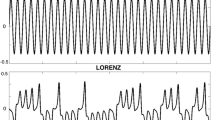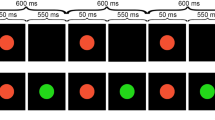Abstract
The current study examined whether the amount and location of available movement information influenced the stability of visuomotor coordination. Participants coordinated a handheld pendulum with an oscillating visual stimulus in an inphase and antiphase manner. The effects of occluding different amounts of phase at different phase locations were examined. Occluding the 0°/180° phase locations (end-points) significantly increased the variability of the visuomotor coordination. The amount of occlusion had little or no affect on the stability of the coordination. We concluded that the end-points of a visual rhythm are privileged and provide access to movement information that ensures stable coordination. The results are discussed with respect to the proposal of Bingham (Ecol Psychol 16:45–43, 2004) and Wilson et al. (Exp Brain Res 165:351–361, 2005) that the relevant information for rhythmic visual coordination is relative direction information.


Similar content being viewed by others
Notes
Compared to the small magnitude difference in amplitude measured in the present study, in a related experiment by de Rugy et al. (2008) even a threefold increase in stimulus amplitude had no influence on the stability of visuo-motor coordination.
The results of a pilot experiment that included manipulation of the location of occlusion at a fixed occlusion amount of 80° revealed that the variability of relative phase was equal to control (no occlusion) in all but the end-point occlusion location condition.
References
Amazeen PG, Schmidt RC, Turvey MT (1995) Frequency detuning of the phase entrainment dynamics of visually coupled rhythmic movements. Biol Cybern 72:511–518
Bingham GP (1995) The role of perception in timing: feedback control in motor programming and task dynamics. In: Covey E, Hawkins H, McMullen T, Port R (eds) Neural representation of temporal patterns. Plenum Press, New York, pp 129–157
Bingham GP (2004a) A perceptually driven dynamical model of bimanual rhythmic movements (and phase entrainment). Ecol Psychol 16:45–53
Bingham GP (2004b) Another timing variable composed of state variables: phase perception and phase driven oscillators. In: Hecht H, Savelsbergh GJP (eds) Theories of time-to-contact—advances in psychology series. Elsevier, Amsterdam, pp 421–442
Bingham GP, Zaal F (1999) Effect of frequency on visual perception of relative phase matches bimanual coordination results. Invest Ophthalmol Vis Sci 40:S413–S413
Bingham GP, Zaal FTJM, Shull JA, Collins DR (2001) The effect of frequency on the visual perception of relative phase and phase variability of two oscillating objects. Exp Brain Res 136:543–552
Byblow WD, Chua R, Goodman D (1995) Asymmetries in coupling dynamics of perception and action. J Mot Behav 27:123–137
Ceux T, Buekers MJ, Montagne G (2003) The effects of enhanced visual feedback on human synchronization. Neurosci Lett 349:103–106
de Rugy A, Salesse R, Oullier O, Temprado JJ (2006) A neuro-mechanical model for interpersonal coordination. Biol Cybern 94:427–443
de Rugy A, Oullier O, Temprado JJ (2008) Stability of rhythmic visuo-motor tracking does not depend on relative velocity. Exp Brain Res 184(2):269–273
Haken H, Kelso JAS, Bunz H (1985) A theoretical model of phase transitions in human hand movements. Biol Cybern 51:347–356
Kelso JAS, DelColle JD, Schöner G (1990) Action-perception as a pattern formation process. In: Jeannerod M (ed) Attention and performance XIII, vol 5. Erlbaum, Hillsdale, pp 139–169
Kugler PN, Turvey MT (1987) Information, natural law, and the self-assembly of rhythmic movement. Erlbaum, Hillsdale
Liao MJ, Jagacinski RJ (2000) A dynamical systems approach to manual tracking performance. J Mot Behav 32:361–378
Mechsner F, Kerzel D, Knoblich G, Prinz W (2001) Perceptual basis of bimanual coordination. Nature 414:69–72
Peper CE, Beek PJ (1998) Are frequency-induced transitions in rhythmic coordination mediated by a drop in amplitude? Biol Cybern 79:291–300
Richardson MJ, Marsh KL, Schmidt RC (2005) Effects of visual and verbal interaction on unintentional interpersonal coordination. J Exp Psychol Hum Percept Perform 31:62–79
Richardson MJ, Marsh KL, Isenhower R, Goodman J, Schmidt RC (2007) Rocking together: dynamics of intentional and unintentional interpersonal coordination. Hum Mov Sci 26:867–891
Roerdink M, Peper CE, Beek PJ (2005) Effects of correct and transformed visual feedback on rhythmic visuo-motor tracking: tracking performance and visual search behavior. Hum Mov Sci 24:379–402
Roerdink M, Ophoff ED, Peper CE, Beek PJ (2008) Visual and musculoskeletal underpinnings of anchoring in rhythmic visuomotor coordination. Exp Brain Res 184:143–156
Russell DM, de Rugy A, Sternad D (2004) The role of the resonance frequency in rhythmic visuo-motor coordination (unpublished manuscript)
Schmidt RC, Turvey MT (1994) Phase-entrainment dynamics of visually coupled rhythmic movements. Biol Cybern 70:369–376
Schmidt RC, Carello C, Turvey MT (1990) Phase transitions and critical fluctuations in the visual coordination of rhythmic movements between people. J Exp Psychol Hum Percept Perform 16:227–247
Schmidt RC, Shaw BK, Turvey MT (1993) Coupling dynamics in interlimb coordination. J Exp Psychol Hum Percept Perform 19:397–415
Schmidt RC, Bienvenu M, Fitzpatrick PA, Amazeen PG (1998) A comparison of intra- and interpersonal interlimb coordination: coordination breakdowns and coupling strength. J Exp Psychol Hum Percept Perform 24:884–900
Schmidt RC, Richardson MJ, Arsenault C, Galantucci B (2007) Visual tracking and entrainment to an environmental rhythm. J Exp Psychol Hum Percept Perform 33:860–870
Schöner G, Haken H, Kelso JAS (1986) A stochastic theory of phase transitions in human movement. Biol Cybern 53:247–257
Temprado JJ, Laurent M (2004) Attentional load associated with performing and stabilizing a between-persons coordination of rhythmic limb movements. Acta Psychol 115:1–16
Temprado JJ, Swinnen SP, Carson RG, Tourment A, Laurent M (2003) Interaction of directional, neuromuscular and egocentric constraints on the stability of preferred bimanual coordination patterns. Hum Mov Sci 22:339–363
Wilson AD, Collins DR, Bingham GP (2005a) Human movement coordination implicates relative direction as the information for relative phase. Exp Brain Res 165:351–361
Wilson AD, Collins DR, Bingham GP (2005b) Perceptual coupling in rhythmic movement coordination—stable perception leads to stable action. Exp Brain Res 164:517–528
Zaal FTJM, Bingham GP, Schmidt RC (2000) Visual perception of mean relative phase and phase variability. J Exp Psychol Hum Percept Perform 26:1209–1220
Acknowledgments
The authors would like to thank Justin Goodman for his help with data collection and Bruce Kay, Kerry Marsh, and Michael Turvey for their helpful comments. This work was funded by National Science Foundation Grants BSC-0240277, BCS-0240266, and BCS-0750190.
Author information
Authors and Affiliations
Corresponding author
Rights and permissions
About this article
Cite this article
Hajnal, A., Richardson, M.J., Harrison, S.J. et al. Location but not amount of stimulus occlusion influences the stability of visuomotor coordination. Exp Brain Res 221, 351–355 (2012). https://doi.org/10.1007/s00221-009-1982-3
Received:
Accepted:
Published:
Issue Date:
DOI: https://doi.org/10.1007/s00221-009-1982-3




